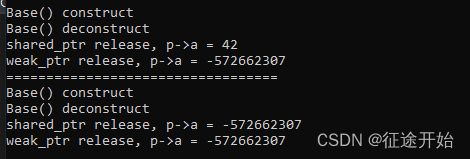先看代码:
class Base
{
public:
Base(int num):a(num) {std::cout << "Base() construct" << std::endl;}
~Base() {std::cout << "Base() deconstruct" << std::endl;}
int Get() {return a;}
private:
int a;
};
void testc()
{
std::cout << "******************************" << std::endl;
std::cout << "******************************" << std::endl;
Base *p;
{
std::weak_ptr<Base> gw;
{
auto sp = std::make_shared<Base>(42);
gw = sp;
p = sp.get();
}
std::cout << "shared_ptr release, p->a = " << p->Get() << std::endl;
}
std::cout << "weak_ptr release, p->a = " << p->Get() << std::endl;
}
void testd()
{
std::cout << "==================================" << std::endl;
Base *p;
{
std::weak_ptr<Base> gw;
{
std::shared_ptr<Base> sp(new Base(42));
gw = sp;
p = sp.get();
}
std::cout << "shared_ptr release, p->a = " << p->Get() << std::endl;
}
std::cout << "weak_ptr release, p->a = " << p->Get() << std::endl;
}执行结果如下:

在testc()中,只有weak_ptr生命周期也结束后,Base对象内存才真正被回收,虽然Base在shared_ptr生命周期结束后就执行了析构函数,但对象所占用的内存还未被马上回收。
而在testd()中,由于使用了new分配对象内存,Base对象内存和智能指针控制块内存不在一起,所以当shared_ptr生命周期结束后就释放了Base对象所占内存。
结论:
1、make_shared只分配一次内存,智能指针控制块和管理的对象存在同一块内存里。new初始化智能指针需要调用两次内存分配,一次给控制块分配内存,一次给对象分配内存。
2、异常安全性。当在函数的实参里初始化智能指针,使用new初始化有发生异常安全性的风险,如 function_a(std::shared_ptr ptr1(new int(100)), function_b()); 编译器可能产生代码: 1先new对象,2再执行函数function_b,3最后将new对象的指针赋给智能指针,如果第2步 function_b发生异常退出,将导致内存泄漏。
3、对象内存被延迟回收:当使用了弱指针weak_ptr引用shared_ptr时,使用make_shared初始化因为控制块和对象都在同一块内存里,虽然管理的对象已经执行析构函数,但由于weak_ptr没有释放,导致内存生命周期被意外延长,只有weak_ptr生命周期结束后,整块内存才一起被回收。






















 5072
5072











 被折叠的 条评论
为什么被折叠?
被折叠的 条评论
为什么被折叠?








